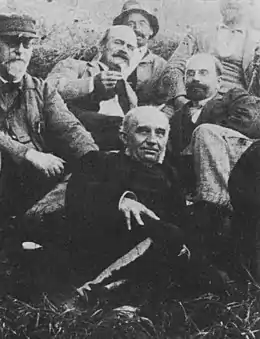James Mourant Du Port
James Mourant Du Port ( – ) est un chanoine et mycologue anglais, né à Saint Pierre Port (Guernesey),

| Naissance | |
|---|---|
| Décès |
(à 66 ans) |
| Nationalité | |
| Activités |
Biographie
Il fait ses études à Elizabeth College et obtient une bourse d'études pour le Gonville and Caius College de Cambridge où il obtient son baccalauréat en 1852 et enseigne, avec le titre de Maître de conférence en hébreu, de 1855 à 1862, jusqu'à sa nomination de vicaire de Mattishall (en) (Norfolk). Il y reste jusqu'en 1884, date à laquelle il est nommé recteur de Denver (Norfolk), jusqu'à sa mort le 21 février 1899.
Une notice nécrologique parue dans le bulletin de la British Mycological Society déclare qu'il « s'intéressait vivement aux sciences naturelles, son plus grand plaisir étant l'étude de la botanique dont il possédait de bonnes connaissances pratiques. »
Il était surtout connu en tant que "fongologue" (mycologue) et a participé pendant de nombreuses années aux excursions mycologiques du Woolhope Club dont il était membre honoraire.
Le chanoine Du Port, recteur de la paroisse de Denver en Grande-Bretagne, francophone et francophile, participait aux sessions de la Société mycologique de France, dont Quélet était président. Plusieurs espèces lui ont été dédiées :
- Pestalozzia
- Xanthochrous
- Russula Du Portii, qui figure à la planche 1042 des " illustrations" de Cooke.
De nombreux amis affligés ont assisté à ses funérailles, parmi lesquels les évêques de Norwich et Thetford et le président de la Norwich Society, le Dr C. B. Plowright, également son médecin traitant.
Sélection de publications
- The Fungoid Diseases of Cereals, Transactions of the Norfolk and Norwich Naturalists Society Vol. 3, p. 194
- Notes on some of the Rarer Fungi found in or near Mattishall in 1880, Transactions - Norfolk and Norwich Naturalists' Society, Volume 3 p. 199-203[1]
- "On some species of Tricholoma not easily distinguished," Wool. Trans., 1883.
- "6th the colours of the fungi as indicated by the Latin words used by Fries," Ib., p.113.
- "The unexpected appearance of two species of fungi in a field quite recently under cultivation," Ib. 1890, p.122.
- "On a remarkable appearance of fungi," Ib. 1893, p. 558.
Notes et références
- Agaricus (hebeloma) asterosporus, a new species, described and named by Dr. Quélet in 1879, grows very plentifully in a mixed wood of beech and oak at Mattishall. It is somewhat like Agaricus rimosus, but the colour of the stem, and the peculiar shape of its bulbous base, besides the stellate form of the spores, mark it very distinctly. I had previously been puzzled by it because of these characteristics, which distinguish it from Agaricus rimosus. Russula fellea, which had not been recognized in the British Isles till last year, grows freely in the same wood, and on the Western Broadway between Honingham and Weston. Many species of Russula< are not very easily distinguished from each other, but the straw-coloured stem, and the arrangement of the gills, clearly separate this species from Russula ochroleuca. On November 12th I found a Polyporus in this same wood, which Mr. Plowright pronounced to be Polyporus picipes, an uncommon species. A Lactarius, found on August 12th at Mattishall Bergh, somewhat like Lactarius torminosus, after comparison with a specimen sent by Mr. Renny from Switzerland, seems most probably to be Lactarius scrobiculatus. I hope to find another specimen of the plant next year, which may decide the name, as this species has not yet been noticed in England. In the last week of September some Swede Turnips at Mattishall were affected with what seemed to bo a prodigious quantity of Peronospora parasitica. On closer examination this was seen to be a new disease among Turnips, Oidium balsamii, figured and described by Mr. Worthhigton Smith in the 'Gardener's Chronicle' for 25th September, 1880. Though the leaves were covered with the fungus, the roots did not seem to have suffered much. This fungus had only been found before on Mulleins and Strawberry plants.